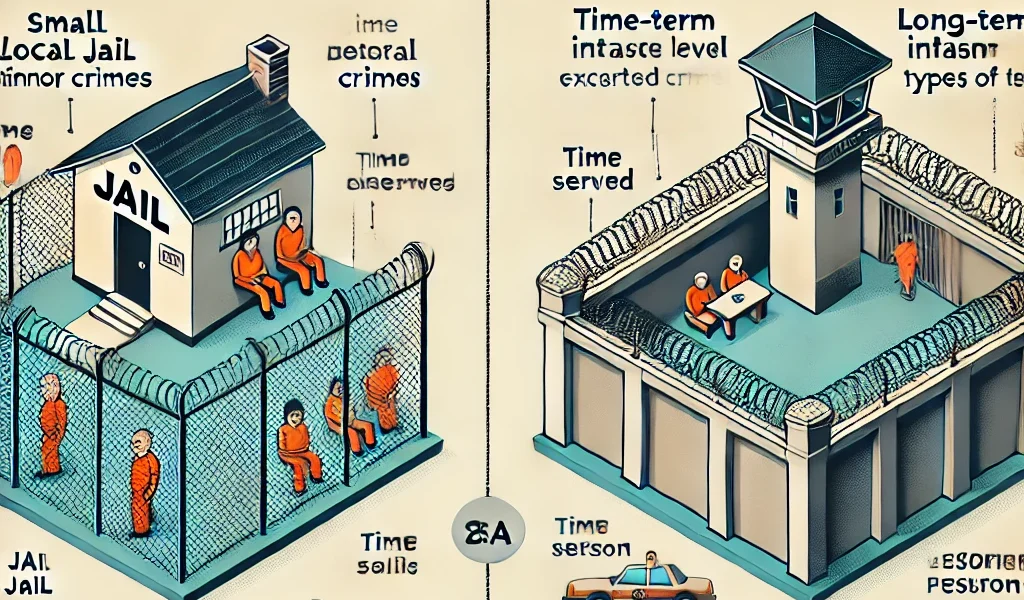What Are the Differences Between Jail and Prison?
When people talk about incarceration, the terms “jail” and “prison” are often used interchangeably. However, these two types of facilities serve different purposes and have key distinctions. Understanding the differences between jail and prison can clarify how the criminal justice system operates and the varying conditions faced by individuals in these institutions.
Definition of Jail
A jail is typically a short-term detention facility operated by local law enforcement, such as a city or county government. Jails are used for several purposes:
- Pretrial Detention: Individuals awaiting trial or sentencing are often held in jail if they are unable to post bail.
- Short-Term Sentencing: Jails house individuals convicted of minor crimes, such as misdemeanors, who are serving short sentences, usually less than one year.
- Temporary Detention: Arrested individuals may be held in jail temporarily while their case is processed or until they are transferred to another facility.
Jails are generally smaller than prisons and have higher turnover rates, with inmates frequently moving in and out as they await trial or serve short sentences.
Definition of Prison
A prison is a long-term correctional facility run by the state or federal government. Prisons are designed to house individuals convicted of more serious crimes, usually felonies, and serve sentences longer than one year. These facilities are intended for rehabilitation, punishment, and isolation of individuals who pose a greater risk to society.
Prisons are typically divided into different security levels:
- Minimum Security: For non-violent offenders or those close to release, with more freedom of movement.
- Medium Security: For inmates with a moderate risk, with stricter regulations and controlled environments.
- Maximum Security: For violent or dangerous offenders, with stringent control and surveillance.
- Supermax Prisons: The most secure type of prison, often reserved for the most dangerous inmates, including those involved in terrorism or organized crime.
Key Differences Between Jail and Prison
- Length of Stay
- Jail: Inmates in jail typically stay for short periods—either awaiting trial, sentencing, or serving sentences under a year.
- Prison: Inmates in prison serve longer sentences, often spanning years or even decades, depending on the severity of their crime.
- Type of Offenders
- Jail: Individuals in jail are generally being held for misdemeanors, such as petty theft, public intoxication, or minor drug offenses. Many have not yet been convicted and are awaiting trial.
- Prison: Prisons house convicted felons who have committed serious crimes such as murder, armed robbery, or drug trafficking.
- Management and Operation
- Jail: Jails are typically run by local governments or county sheriffs. They serve a local population and are funded at the municipal or county level.
- Prison: Prisons are operated by state or federal governments and house inmates from across the state or country. They tend to have larger budgets and more extensive rehabilitation programs.
- Facilities and Resources
- Jail: Jails often have fewer resources and rehabilitation programs due to the short-term nature of their population. Inmates may have access to basic education and work programs, but options are limited.
- Prison: Prisons, especially long-term facilities, typically offer more comprehensive services like vocational training, counseling, educational programs, and even specialized units for inmates with mental health or substance abuse issues.
- Daily Operations
- Jail: Jails have a faster pace, with inmates frequently entering and leaving. The transient nature of jails means that there’s less focus on long-term rehabilitation and more emphasis on managing short-term needs.
- Prison: Prisons have more structured daily operations, as inmates are expected to be there for extended periods. This allows for the development of more detailed rehabilitation programs, work assignments, and other activities aimed at reducing recidivism.
Conditions in Jail vs. Prison
The conditions in jails and prisons can vary widely based on the location, funding, and management of the facility. However, jails, due to their short-term nature, often provide less stability for inmates. Overcrowding, limited access to health care, and a lack of rehabilitation programs are common complaints in many jails.
Prisons, while designed for long-term stays, can also face issues with overcrowding and underfunding. However, the more structured environment in prisons often provides inmates with access to better health care, education, and rehabilitation resources compared to jails.
Conclusion
While the terms “jail” and “prison” are often used interchangeably in everyday conversation, they represent distinct types of incarceration facilities within the criminal justice system. Jails are short-term facilities for individuals awaiting trial or serving minor sentences, while prisons are long-term facilities for those convicted of serious crimes. Understanding these differences helps clarify how individuals are processed through the legal system and the varying conditions they face in these institutions.




